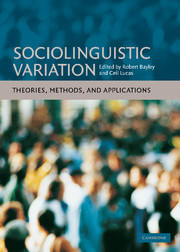Book contents
- Frontmatter
- Contents
- 1 List of figures
- 2 List of tables
- Acknowledgments
- Notes on editors and contributors
- Introduction
- Part 1 THEORIES
- 1 Variation and phonological theory
- 2 Syntactic variation
- 3 The psycholinguistic unity of inherent variability: old Occam whips out his razor
- 4 The study of variation in historical perspective
- 5 Style in dialogue: Bakhtin and sociolinguistic theory
- 6 Variation and historical linguistics
- 7 Second language acquisition: a variationist perspective
- 8 Variation and modality
- Part 2 METHODS
- Part 3 APPLICATIONS
- Afterword: Walt Wolfram and the study of sociolinguistic variation
- References
- Index
4 - The study of variation in historical perspective
Published online by Cambridge University Press: 16 February 2010
- Frontmatter
- Contents
- 1 List of figures
- 2 List of tables
- Acknowledgments
- Notes on editors and contributors
- Introduction
- Part 1 THEORIES
- 1 Variation and phonological theory
- 2 Syntactic variation
- 3 The psycholinguistic unity of inherent variability: old Occam whips out his razor
- 4 The study of variation in historical perspective
- 5 Style in dialogue: Bakhtin and sociolinguistic theory
- 6 Variation and historical linguistics
- 7 Second language acquisition: a variationist perspective
- 8 Variation and modality
- Part 2 METHODS
- Part 3 APPLICATIONS
- Afterword: Walt Wolfram and the study of sociolinguistic variation
- References
- Index
Summary
Variationist linguistic analysis
As Milroy and Gordon (2003:5) document in their introduction to sociolinguistics, variationist methodology is often considered a subfield of sociolinguistics. Chambers maintains a similar view: “The social significance of language variation is only one aspect of the discipline of sociolinguistics, broadly conceived” (2002b:1). The current chapter focuses primarily on developments within sociolinguistic variation research but also notes that other traditionally nonsociolinguistic fields have also employed variationist methodology. For a superb comparison of variationist and formal linguistic scholarly roots, see Chambers' (2002b) Correlations which details why the axiom of categoricity is a postulate language scholars must either adopt or reject (2002b:15). Here, this chapter is intended to provide a hint as to why so many scholars, including many outside of sociolinguistics proper, have chosen to reject it.
Preston describes the quantitative sociolinguistic paradigm as one where language variation is not random: “The frequency of their [variable elements] occurrences is predicted (a) by the shape and identity of the element itself and its linguistic context; (b) by the stylistic level of the interactions; and (c) by the social identities a [sic] relationships of the interlocutors” (2001:691). The emphasis is on how language variation works; variationist scholars reject models where variation is an aberrant state between two seemingly stable states, instead following the concept of inherent variability first propagated by Weinreich, Labov, and Herzog (1968).
Although a wide variety of arguments are made in variationist work, they generally adhere to some basic tenets. Jones and Tagliamonte enumerate these “lines of evidence: (1) Which of the following factors is statistically significant? (2) What is the relative contributions of the linguistic features selected? Is it strong or weak?
- Type
- Chapter
- Information
- Sociolinguistic VariationTheories, Methods, and Applications, pp. 70 - 89Publisher: Cambridge University PressPrint publication year: 2007
- 8
- Cited by



